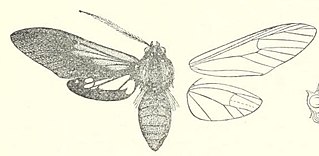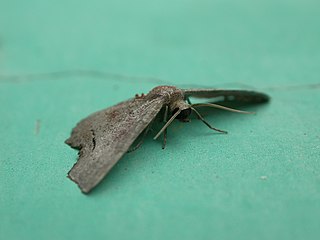
Urodidae, whose species are commonly known as false burnet moths, is a family of moths in the lepidopteran order. It is the type genus in the superfamily, Urodoidea, with three genera, one of which, Wockia, occurs in Europe.

Heliodinidae, commonly known as sun moths, is a family of small moths with slender bodies and narrow wings. Members of this family are found in most parts of the world. Heliodinid moths are brightly coloured day-flying moths. The base of the haustellum is bare. The scales on the head are compact and appear like a shield. Many Heliodinidae raise their hindlegs when resting but this is not a taxonomic feature and several genera like Epicroesa and Lamprolophus do not show this posture. Many Heliodinidae have the inner and outer spurs of the metatibia subequal. The larval host plants of the majority of species are in the Aizoaceae, Chenopodiaceae, Phytolaccaceae, Portulacaceae and Nyctaginaceae, all in the Order Caryophyllales. A few feed on Onagraceae, Araliaceae and Piperaceae. The pupae have long stiff hairs on their back sides.
Metachanda is the sole genus in tribe Metachandini of moth subfamily Oecophorinae. Metachandini was originally described as family Metachandidae by Edward Meyrick in 1911, and at the time also contained the genus Chanystis, which is currently unplaced to tribe within Oecophorinae. It has also previously been described as tribe Metachandini of subfamily Gelechiinae.
Agathiphaga is a genus of moths, known as kauri moths. and is the only living genus in the family Agathiphagidae. This caddisfly-like lineage of primitive moths was first reported by Lionel Jack Dumbleton in 1952, as a new genus of Micropterigidae.

Ixylasia is a genus of moths in the subfamily Arctiinae. The genus was erected by Arthur Gardiner Butler in 1876.
Atypha is a monotypic moth genus of the family Noctuidae erected by Jacob Hübner in 1821. Its only species, Atypha pulmonaris, was first described by Eugenius Johann Christoph Esper in 1790. It is found in southern and central Europe, northern Turkey, Transcaucasia and the Caucasus.

Diphtherinae is a monotypic subfamily of moths in the family Nolidae erected by Michael Fibiger and J. Donald Lafontaine in 2005. Its only genus, Diphthera, was erected by Jacob Hübner in 1809. The genus was moved from Noctuidae in 2013 after the phylogenetic analysis of Reza Zahiri et al. (2013).

Polygrammate is a monotypic moth genus of the family Noctuidae. Its only species, Polygrammate hebraeicum, the Hebrew moth or Hebrew, is found in the eastern parts of North America, from Ontario, south to Florida and as far west as Texas. Both the genus and the species were first described by Jacob Hübner in 1818.
Somatoxena is a monotypic moth genus in the subfamily Lymantriinae erected by Per Olof Christopher Aurivillius in 1904. Its only species, Somatoxena lasea, was first described by Herbert Druce in 1899. It is found in Sierra Leone.
Anthalma is a monotypic moth genus in the family Geometridae. Its only species, Anthalma latifasciata, is found in Panama. Both the genus and species were first described by Warren in 1901.

Blepharoctenucha is a monotypic moth genus in the family Geometridae described by Warren in 1895. Its only species, Blepharoctenucha virescens, first described by Arthur Gardiner Butler in 1880, is known from India and Taiwan.
Celonoptera is a monotypic moth genus in the family Geometridae. Its only species, Celonoptera mirificaria, is found in south-eastern Europe. Both the genus and species were first described by Julius Lederer in 1862.
Ithysia is a monotypic moth genus in the family Geometridae. Its only species is Ithysia pravata. The genus was erected by Jacob Hübner in 1825, but the species had been first described by Hübner in 1813.
Megalotica is a genus of moths in the family Geometridae described by Zimmerman in 1958.

Xenozancla is a monotypic moth genus in the family Geometridae. Its only species, Xenozancla versicolor, is found in northern India. Both the genus and species were first described by William Warren in 1893.
Ixylasia pyroproctis is a moth of the subfamily Arctiinae. It was described by Herbert Druce in 1905. It is found in Venezuela.
Ixylasia schausi is a moth of the subfamily Arctiinae. It was described by Herbert Druce in 1896. It is found in Mexico.
Ixylasia semivitreata is a moth of the subfamily Arctiinae. It was described by George Hampson in 1905. It is found in the Brazilian states of Rio de Janeiro and Santa Catarina.

Ixylasia trogonoides is a moth of the subfamily Arctiinae. It was described by Francis Walker in 1864. It is found in Brazil.
The large moth subfamily Arctiinae, the tiger moths, contains the following genera that have not yet been classified into one of the three tribes in the subfamily. This is a list of 167 extant genera, representing around 732 extant species, out of more than 9,000 in the whole of Arctiinae.






